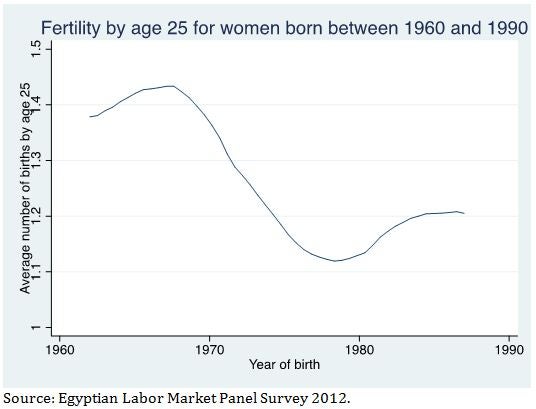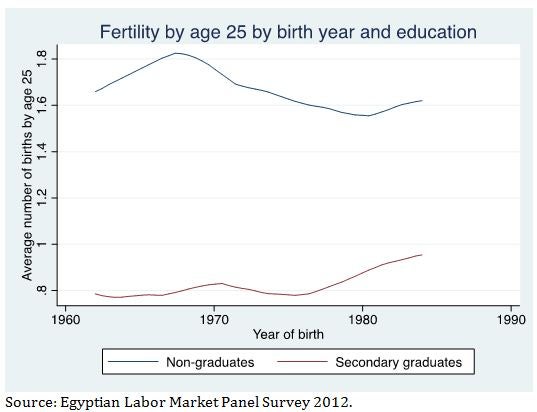“Demography is destiny” – attributed to Auguste Comte
After dropping for many years, there has been a recent resurgence of fertility rates in Egypt. A woman born in the 1960s gave birth to an average of 1.4 children by the time she turned 25. Then there came a sharp drop, bottoming out at near 1.1 for women born in the late 1970s. But since then, fertility rates have bounced back, up to an average of 1.2 for women born in the mid to late 1990s.

 There are a couple of possible explanations for this. As an economist, I am always looking for economic clues for phenomena. In this instance, I focused on the potential role that women’s employment opportunities might play in determining fertility rates. In Egypt (as in most of the world), women are typically the ones who spend the most time caring for children. It is harder to start a career if you have a young child to take care of, and the more children you have the harder it can get. So one potential explanation for an increase in fertility rates is that Egyptian women used to have good access to jobs, but for recent generations that access has waned.
There are a couple of possible explanations for this. As an economist, I am always looking for economic clues for phenomena. In this instance, I focused on the potential role that women’s employment opportunities might play in determining fertility rates. In Egypt (as in most of the world), women are typically the ones who spend the most time caring for children. It is harder to start a career if you have a young child to take care of, and the more children you have the harder it can get. So one potential explanation for an increase in fertility rates is that Egyptian women used to have good access to jobs, but for recent generations that access has waned.
And this seems to be exactly what has happened in Egypt. Beginning in 1964, the Egyptian government had a policy of guaranteeing employment to every secondary school graduate, male and female. At some point, this got too expansive (especially since the number of secondary school graduates skyrocketed) and the employment guarantee program gradually became defunct. We can see this clearly when we look at how many Egyptians had a job in the public sector at age 25. Among secondary graduates, over half of those born in the late 1950s worked for the public sector in some capacity at age 25, but among the most recent generations, that number becomes less than 1 in 7.

If we look at fertility rates broken into secondary graduates and non-graduates, we see some evidence that employment opportunities might be at least part of the story here. While fertility rates have been rising for both graduates and non-graduates, it is the educated women who are really driving the overall effect. Even though they have fewer children overall, the educated women are the ones who have experienced the largest recent increase in birth rate. In fact, what is remarkable is that educated Egyptians haven’t had fertility decreases at all over the last 40 years, which may be because their job market prospects have only been getting worse and worse as time goes on.

Of course, the big question is, “why should we care?” It is not my place to tell Egyptian families how many children to have, or that they’re having too many kids or too few. However, from a practical standpoint, this has put Egypt in a fairly unique position. Many countries have, at one point or another, experienced a “youth bulge” in which a very large fraction of the population are in their late teens or early twenties. The US, for instance, had a youth bulge about 30 years ago as the large post-World War 2 generation (the “baby boomers”) started to grow up.

Source: Current Population Survey
Egypt is just now finishing up a youth bulge, just like the US and most other rich countries did decades ago. However, because of resurgent fertility rates, Egypt now has a second, much larger youth bulge coming down the pipeline in just a few years. This is something the Egyptian government should be keeping in mind as it sets policies over the next few years.

Source: Egyptian Labor Market Panel Survey 2012
After dropping for many years, there has been a recent resurgence of fertility rates in Egypt. A woman born in the 1960s gave birth to an average of 1.4 children by the time she turned 25. Then there came a sharp drop, bottoming out at near 1.1 for women born in the late 1970s. But since then, fertility rates have bounced back, up to an average of 1.2 for women born in the mid to late 1990s.

 There are a couple of possible explanations for this. As an economist, I am always looking for economic clues for phenomena. In this instance, I focused on the potential role that women’s employment opportunities might play in determining fertility rates. In Egypt (as in most of the world), women are typically the ones who spend the most time caring for children. It is harder to start a career if you have a young child to take care of, and the more children you have the harder it can get. So one potential explanation for an increase in fertility rates is that Egyptian women used to have good access to jobs, but for recent generations that access has waned.
There are a couple of possible explanations for this. As an economist, I am always looking for economic clues for phenomena. In this instance, I focused on the potential role that women’s employment opportunities might play in determining fertility rates. In Egypt (as in most of the world), women are typically the ones who spend the most time caring for children. It is harder to start a career if you have a young child to take care of, and the more children you have the harder it can get. So one potential explanation for an increase in fertility rates is that Egyptian women used to have good access to jobs, but for recent generations that access has waned.
And this seems to be exactly what has happened in Egypt. Beginning in 1964, the Egyptian government had a policy of guaranteeing employment to every secondary school graduate, male and female. At some point, this got too expansive (especially since the number of secondary school graduates skyrocketed) and the employment guarantee program gradually became defunct. We can see this clearly when we look at how many Egyptians had a job in the public sector at age 25. Among secondary graduates, over half of those born in the late 1950s worked for the public sector in some capacity at age 25, but among the most recent generations, that number becomes less than 1 in 7.

If we look at fertility rates broken into secondary graduates and non-graduates, we see some evidence that employment opportunities might be at least part of the story here. While fertility rates have been rising for both graduates and non-graduates, it is the educated women who are really driving the overall effect. Even though they have fewer children overall, the educated women are the ones who have experienced the largest recent increase in birth rate. In fact, what is remarkable is that educated Egyptians haven’t had fertility decreases at all over the last 40 years, which may be because their job market prospects have only been getting worse and worse as time goes on.

Of course, the big question is, “why should we care?” It is not my place to tell Egyptian families how many children to have, or that they’re having too many kids or too few. However, from a practical standpoint, this has put Egypt in a fairly unique position. Many countries have, at one point or another, experienced a “youth bulge” in which a very large fraction of the population are in their late teens or early twenties. The US, for instance, had a youth bulge about 30 years ago as the large post-World War 2 generation (the “baby boomers”) started to grow up.

Source: Current Population Survey
Egypt is just now finishing up a youth bulge, just like the US and most other rich countries did decades ago. However, because of resurgent fertility rates, Egypt now has a second, much larger youth bulge coming down the pipeline in just a few years. This is something the Egyptian government should be keeping in mind as it sets policies over the next few years.

Source: Egyptian Labor Market Panel Survey 2012


Join the Conversation